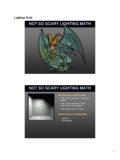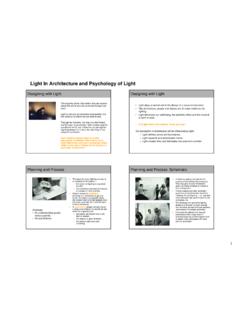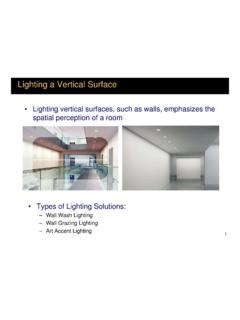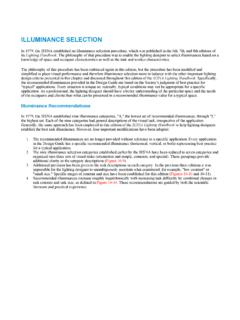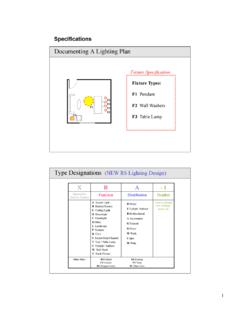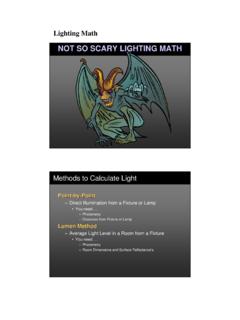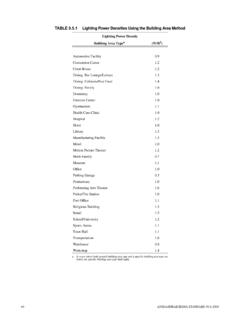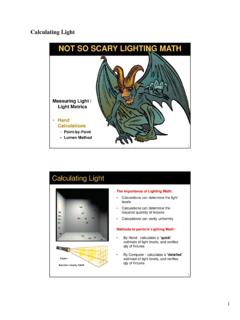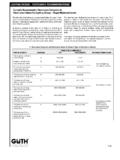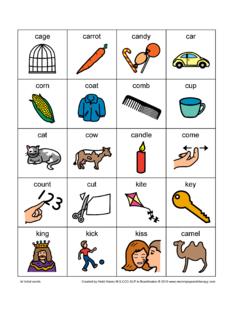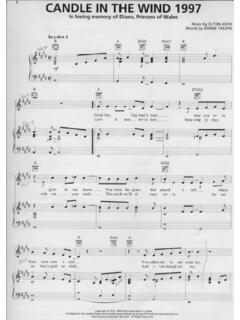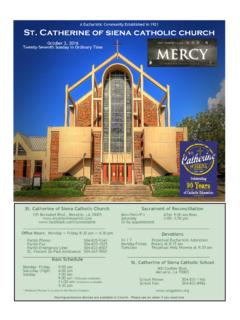Transcription of Lighting Math NOT SO SCARY LIGHTING MATH …
1 LIGHTING Math1 NOT SO SCARY LIGHTING MATHNOT SO SCARY LIGHTING MATHThe directdirectillumination from one candle placed at a distance ofone foot from a surface is defined foot1 foot--candlecandle(abbreviation = fc)FootFoot--candlecandleis also known as a unit of light or light level. 1 foot1 fcLight The Foot-candleThe energy of light from a candle falling on a one foot squareareaisOne Lumen(abbreviation = lm)The total amount of light coming out of the candlecandleis approximately 13 lumens13 lumensThe total amount of light coming out of 100100--watt Awatt A--lamplampis approximately 1650 lumens1650 lumensNOT DEFINED BY DISTANCE1 lmLight The LumenDistribution CurveDistribution Curverepresents the total light pattern produced by a sourceCandelaCandelais the intensity of light at any given The CandelaDistribution CurvePolar Chart0 deg90 deg180 deg270 degCandelaLighting Math2 Lumens versus Candelas LumenLumenis an amount of ENERGY CandelaCandelais an amount of INTESITY Lamp output can be measured in Lumens Lumens and CandelasCandelas.
2 Fixtures alter LumenLumenand Candela Candela output (Their values can only be found in Photometry Reports)Light MeasurementMeasures the candlepower distribution of a particular lamp or is generated in a --Photometric reportIntegrating SphereThe Spectro-RadiometerGonio-PhotometerMethod s to Calculate LightPointPoint--byby--PointPoint Direct Illumination from a Fixture or Lamp You Photometry Distances from Fixture or LampLumen MethodLumen Method Average Light Level in a Room from a Fixture You Photometry Room Dimensions and Surface Reflectance'sDirection of Light Goal of a luminaire is to put light where the user needs it Convenient way to classify luminaires is by the directionof light emitted from the luminaire Commission Internationale de l Eclairage (CIE)
3 Sets up these classificationsLighting Math3 CIE Luminaire Types / DistributionsDirectSemi-DirectGeneral Diffuse(IES) Direct-IndirectSemi-IndirectIndirectCand lepower Distribution Curve Candlepower Candlepower distribution curvesdistribution curvesprovides intuitive information on how aluminairewill perform CandelaCandelavalues are used in calculations to predict light levels0 deg102030405060708090 deg3003006006009009001200120015001500 Distribution anglesCandle Power DistributionAsymmetrical Distribution CurvePerpendicular 90 degreesCandlepower DistributionCandlepower DistributionParallel 0 degreesCandlepower DistributionCandlepower DistributionRectangular Tubular Fluourescent fixtureRectangular Tubular Fluourescent fixture90 deg Perpendicular0 deg Parallel Plot of candlepower values Summary of candlepower values
4 In different planes Fixture Efficiency Lumen Summary Luminance summary Spacing criteria(SC) or Spacing/Mounting Height (S/MH) for uniformity Coefficient of Utilization Table GuidesPhotometry ReportsLighting Math4 Photometry Reports Lensed DownlightPhotometry Reports Indirect PendantPoint-by-PointFoot- candle = candle PowerDistance2 Ceiling height = 9ftLight Level at FloorFC = 2651candelas/ 9ft2FC = 2651 / 81FC = foot-candles Ceiling Fixture ExampleFoot- candle =2 ElevationSectionPoint-by-PointFoot-candl e = candle PowerDistance2 LIGHTING Math5 Ceiling height = 9ftRoom Width = 12ftTop Head = 6ftLight Level at the WallDPoint-by-PointFoot- candle = candle PowerDistance2 Point-by-PointCeiling height = 9ftRoom Width = 12ftTop Head = 6ftLight Level at the WallDDDXX3ftYY6ftTo solve for D, you the Drawing.
5 TrigonometryTrigonometryXX22+ Y+ Y22= Z= Z2232+ 62= D29 + 36 = D2D= (9 + 36)D= = candle PowerDistance2 Point-by-PointFoot- candle = candle PowerDistance2 Ceiling height = 9ftRoom Width = 12ftTop Head = 6ftLight Level at the WallDXX3ftYY6ftTo solve for Angle, you the Drawing, TrigonometryTrigonometryTan(Angle) = X / YAngle = Tan-1(X / Y)Angle = Tan-1(3 / 6)Angle = 26 degrees??Point-by-PointCeiling height = 9ftRoom Width = 12ftTop Head = 6ftLight Level at the = 169 candelas/ = 169 / = foot-candlesFoot- candle = candle PowerDistance2 LIGHTING Math6 Point-by-Point Factors Calculated Levels are Facing the Light Fixture With the exception of directly belowPoint-by-Point Factors You need to factor an adjustment if you want levels at other angles (IE Horizontal, Vertical Angles) COSINE Adjusted!
6 !COSINE Adjusted!!HorizontalVerticalVerticalCOSI NE AdjustmentsFoot- candle = candle PowerDistance2X COS(Angle of Incidence) Light COSINE AdjustmentCeiling height = 9ftRoom Width = 12ftLight Level at the Vertical to the = CP/D2x COS(angle)FC = 169 / COS(64deg)FC = 169 / x = foot-candles64degLighting Math7 Point-by-Point Factors Calculated Levels are Initial. You need to factor an adjustment for Light Loss Light Loss Factors to Consider Dirt Lamp Depreciation EnvironmentFoot- candle = candle PowerDistance2x COS(Angle) x MFNon-RecoverableRecoverableMF = Maintenance Factors Ballast Factor (Fluourescent approx 90%) Ambient Fixture Temperature Supply Voltage Variation (Low Voltage approx 4%)Non-Recoverable Light Loss Factors Lamp Burnouts (approx 80%) Lamp Lumen Depreciation (Fluourescent approx 70%) Fixture (Luminaire) Dirt Depreciation Indirect LIGHTING (approx 65%) Industrial Environments (ranges from approx 50% to 80%) Open Fixtures Lamp exposed (approx 85%)
7 Recoverable Light Loss FactorsLighting Math8 Multiply one factor against another and you get LIGHT LOSS FACTOR! Foot- candle = candle PowerDistance2x COS(Angle) x MFReview of Formulas To find Dimensions or Angles of a TriangleDistanceDistanceYYXXTo solve for any item, you the Drawing, or Use TrigonometryTrigonometryFormulas:XX22+ Y+ Y22= Distance = Distance 22 Tan (Angle) = X / YTan (Angle) = X / YAngle = TanAngle = Tan--11(X / Y)(X / Y)AngleAngleReview of Formulas Point by PointDistance Distance To calculate direct light need a fixtures candle Power Distribution Formulas:FC =FC =Multiply by Cos(Cos(AngleAngle))for horizontal light levelCandle PowerCandle PowerDistanceDistance22 AngleAngleDistance Distance FCFCFCFCL ightFixtureLightFixtureMethods to Calculate LightPointPoint--byby--PointPoint Direct Illumination from a Fixture or Lamp You Photometry Distances from Fixture or LampLumen MethodLumen Method Average Light Level in a Room from a Fixture You Photometry Room Dimensions and Surface Reflectance'sLighting Math9 Calculations using Lumens LumenLumenis an amount of ENERGY CandelaCandelais an amount of INTESITY Lumen Method Calculation Calculates the Average Illumination for a room.
8 Takes into account the room surface reflectance's but assumes the surfaces are diffuse (not shiny!). Assumes an empty room (without furniture). Can also be used to determine the required Quantity of Fixturesneeded for a target light level. Does not determine light fixture layout or location you must following mnfrs spacing criteria. Plot of candlepower values Summary of candlepower values in different planes Fixture Efficiency Lumen Summary Luminance summary Spacing Criteria(SC) or Spacing/Mounting Height (S/MH) for uniformity Coefficient of Utilization Table GuidesPhotometry ReportsCoefficient of Utilization Also known as CU CU Defines the percentage of light output that is expected from a fixture The value is determined by a CU table For commercial Reflectance ofFor commercial Reflectance of80/50/2080/50/20, the actual CU value is , the actual CU value is Method need Room Dimensions and the Fixture Mounting need to select a Light the rooms Room Cavity Ratio (RCR).
9 The fixtures Coefficient of Utilization for the ! LIGHTING Math10 Room Reflectance Room comprised of Walls, Ceiling, and Floor. Walls typically have Doors and Windows All surfaces have a reflectance value to bounce light. Light from Light Fixture bounces off of all Reflectance Surfaces with less reflectance will bounce less light Typical Reflectance Values: 75%75%--90%90%White, Off White, Grey, Light tints of Blue or Brown 30%30%--60% 60% Medium Green, Yellow, Brown, or Grey 10%10%--20% 20% Dark Grey, Medium Blue 5%5%--10%10%Dark Blue, Brown. Dark Green, and many wood finishes Room Reflectance Typical Commercial Values: 80%80%Ceiling 50%50%Wall 20%20%Floor Typical Industrial Values: 50%50%Ceiling 30%30%Wall 20%20%FloorRoom Cavity Ratio Room Cavity Ratio (aka RCRRCR) is the volume between the FixtureFixtureand Height of CalculationHeight of Calculation Workplane height is typically 30-inches above the floor A rooms RCR will always be between 1 and 105xMHx(L+W)Room AreaRCR = LIGHTING Math11 Room Cavity Ratio The RCRRCRcan vary depending on the height you want to shown here with the calculation height at the (L+W)Room AreaRCR =Room Cavity Ratio The RCRRCRcan vary depending on the height of the shown here with Wall Brackets or (L+W)Room AreaRCR =Room Cavity Ratio The RCRRCRcan vary depending on the height of the shown here with (L+W)Room AreaRCR =Room Cavity RatioExample:Room Width.
10 12ftRoom Length: 15ftCeiling Height: 10ftRCR = 5( )(12+15)(12x15)RCR = = (L+W)Room AreaRCR =Ceiling 10ft8ftTable Math12To Calculate Foot- candle level:To Calculate number of Fixtures:Lumen Method FormulaFC = FC = Qty of Fixtures x Number of Lamps per Fixture x Lumens Qty of Fixtures x Number of Lamps per Fixture x Lumens perperLamp x CULamp x CUArea of the Room Area of the Room FC = FC = Total Lumens in the Room x CUTotal Lumens in the Room x CUArea of the Room Area of the Room Qty of Fixtures =Qty of Fixtures =FC x Area of the RoomFC x Area of the RoomNumber of Lamps per Fixture x Lumens Number of Lamps per Fixture x Lumens perperLamp x CU Lamp x CU Qty of Fixtures =Qty of Fixtures =FC x Area of the RoomFC x Area of the RoomTotal Lumens in the Room x CU Total Lumens in the Room x CU Lumen Method Example 1 What is the resulting Foot- candle Level at table height from four downlights?
